3.2: Der Alltag
- Page ID
- 108806
Aktivität 1. Der Alltag
Now that you already now how to talk about das Studium let’s expand and learn how to describe your every day routine - der Alltag. Was machst du? Wo bist du? Mit wem machst du was? Wann hast du Uni und wann hast du Freizeit?

Aktivität 2. Erins typischer Tag
What are typical days for Erin? Watch her video clip and determine which of the following statements are richtig and which are falsch. Make sure to correct the falsche Aussagen!
| Ich stehe gegen 7 Uhr auf. | R | F |
| Dann mache ich meinen Kaffee und ich spiel’ mit der Katze (cat) ‘rum. | R | F |
| Ich schrei’ meinen Freund an: „Steh auf, du fauler Sack!“ | R | F |
| Wir essen normalerweise kein Frühstück | R | F |
| Nachmittags kommt meine Freundin Louisa vorbei und manchmal spielen wir ein bisschen Racquetball oder so was oder wir backen auch. | R | F |
| Abends entspanne ich mich und schaue “The Simpsons” oder “Family Guy” an oder ich guck’ (to watch) einen Film. | R | F |
| Dann gehe ich ins Bett. | R | F |
Watch Erin’s clip a second time and match the German expressions with their English equivalents.
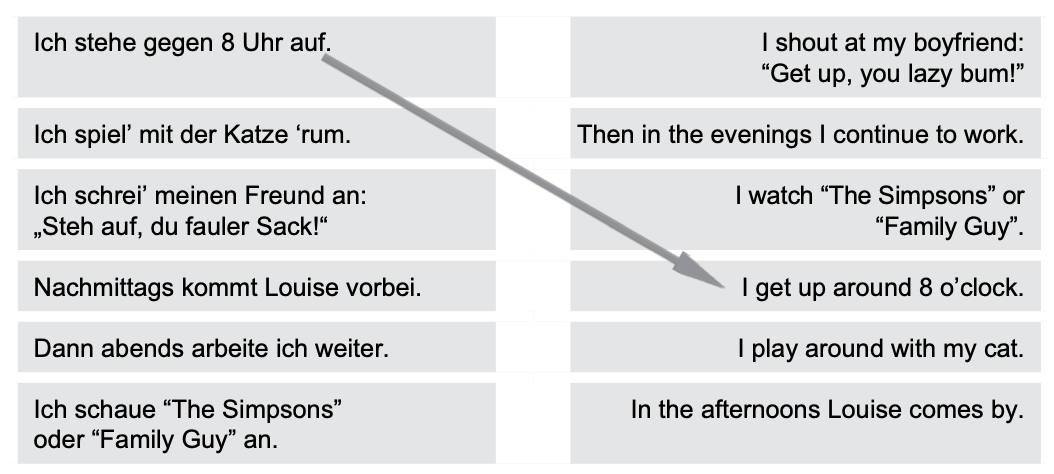
Aktivität 3. Bernas typischer Tag
What is a typical day like for Berna? View her „Ein typischer Tag” video and number her daily routines in the order in which she describes them. How is Berna’s typical day different from Erin’s?
Dann muss ich erst mal essen, weil ich meistens sehr ausgehungert (starved) bin.
Wenn die Kurse fertig (finished) sind, komme ich dann nach Hause.
Dann trinke ich eine Tasse Kaffee, ich dusche mich, mache mich fertig.
Vormittags bin ich damit beschäftigt zu unterrichten, vorbereiten, Tests korrigieren... Dann lese ich wieder weiter für den nächsten Tag.
Ich stehe morgens relativ früh auf, so um sieben.
Dann gehe ich zur Universität.
Nachmittags muss ich dann in meine Kurse reingehen. Dann wird da viel diskutiert.
Aktivität 4. Und was macht Hassan an einem typischen Tag?
Finally, watch as Hassan describes a typical day in his life and answer the following questions based on his responses.
1. Wann steht Hassan morgens auf? _________________________________________
2. Was macht er am Morgen? _______________________________________________
3. Wie lange arbeitet er? ___________________________________________________
4. Was macht er am Nachmittag? ____________________________________________
5. Warum ist Hassan momentan nicht an der Universität? ______________________
Aktivität 5. Der Tagesablauf
Below are some common activities for each part of the day (i.e., mornings, afternoons, evenings, nights). What other common activities can you think of to add to the list? Circle the ones that describe your daily routine.

Aktivität 6. Und was machst du denn den ganzen Tag?
What is a typischer Tag in your life and the life of one of your classmates? In the left column check all the activities that you do and add anything that may apply to you on a typical day. Afterwards ask your partner what s/he goes throughout the day.
| Du: | Was machst du an einem typischen Tag? |
| Dein Partner: | Ich stehe um 11 Uhr auf, trinke Kaffee, aber komme pünktlich zu meinem Deutschkurs! |
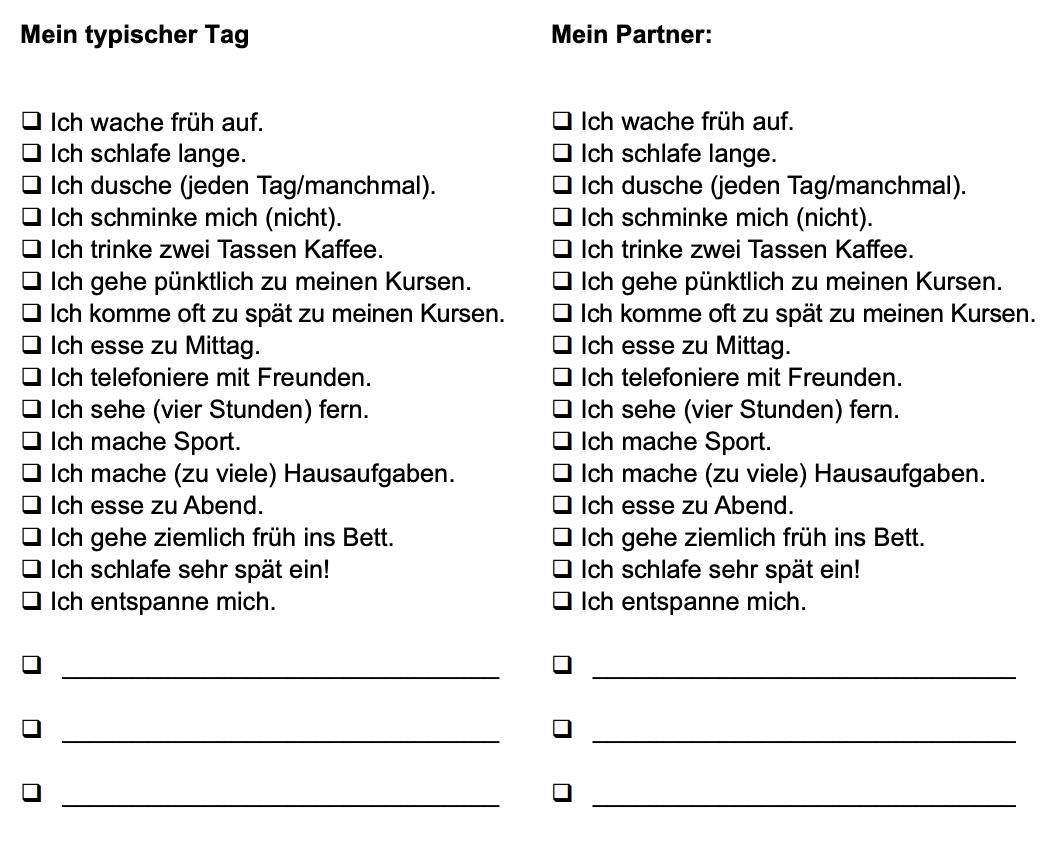
Aktivität 7. Ein typischer Tag im Leben von meinem Lieblingsstar
You may not be able to conduct an interview with your favorite star about their daily routine, but who needs facts nowadays! Brainstorm what you think a typischer Tag for your favorite star looks like and create a fictional interview between you and that star.
| Sie: | Hallo! Schön, Sie kennenzulernen. Ich bin ein großer Fan! |
| Ihr Lieblingsstar: | Danke schön. |
| Sie: | Ok, meine erste Frage ... wie sieht Ihr typischer Tag aus? |
| Ihr Lieblingsstar: |
Aktivität 8. Lieder & Musik
Jürgen von der Lippe – Guten Morgen, liebe Sorgen. Listen to this song by Jürgen von der Lippe, who – in a parody of a popular children’s song –describes a less than desirable day in his imaginary life.
To introduce the song and to learn about the artist, go to Jürgen von der Lippe’s website at http://www.juergenvonderlippe.de. In case you need an audio version of the song, try a search engine such as google or YouTube. In case you cannot find the song, make it a reading exercise, the song text is provided on the next page. If you have a musical class, you can ask them to create their own music matching the lyrics and make a music video.
1. Vor dem Hören/Lesen (Before listening/reading)
a. Was machen Sie am Morgen? (What do you do in the mornings?)
b. Was ist besser (more positive)? Warum?
c. Sind Sie ein Morgenmensch oder ein Nachtmensch? Warum? Ich bin ein __________________________________, weil ___________________________________________________
2. Nach dem Hören/Lesen
a. . Welche Probleme hat er? - - - - - -
b. Wie ist sein Morgen? Markieren Sie die Antworten mit “R” (richtig) oder mit “F” (falsch). _____ Sein Morgen ist fantastisch. Alles läuft gut. _____ Sein Kaffee schmeckt ausgezeichnet. _____ Die Dusche ist entspannend (relaxing). _____ Er hat kein Toilettenpapier. _____ Seine Frau liebt ihn sehr. _____ Sein Tag beginnt nicht gut. Alles läuft schief.
c. Ist sein Morgen gut oder schlecht?
d. Ist er ein Morgenmensch oder ein Nachtmensch? ____________________________________________
3. Weitere Fragen (further questions)
a. Was ist ein Morgenmuffel? Ein Mensch, der gern am Morgen aufsteht. Ein Mensch, der am Morgen lustig ist. Ein Mensch, der am Morgen böse ist. Ein Mensch, der gern lange schlafen will.
b. Sind Sie ein Morgenmuffel? _____________________________________________________________________
Text: Guten Morgen liebe Sorgen
Guten Morgen, liebe Sorgen,
seid ihr auch schon alle da?
Habt ihr auch so gut geschlafen?
Na, dann ist ja alles klar.
Wir schwingen unser linkes Bein
behende aus dem Bett;
der Bettvorleger gibt uns Schwung
bis direkt vors Klosett.
Na, wo wir schon mal da sind,
da bleib’n wir auch hier …
Wooaah! Fertig: wo ist das Papier?
Guten Morgen, liebe Sorgen...
Wenn ein Tag so wunderschön
beginnt, ist alles drin:
heute bleibt die Dusche kalt,
das Wasserrohr ist hin.
Wir gleiten auf den Fliesen aus
und prellen uns den Steiß;
als Krönung schmeckt der Kaffee heute
irgendwie nach Schweiß.
Die Zeitung ist geklaut,
was soll’s, die schreib’n eh nur Dreck —
ein Zettel auf dem Tisch — für mich? —
Aha, die Frau ist weg.
Mit meinem Auto, meinem Hund:
dat nennt die nu Liebe;
die Porno-Sammlung hat sie auch:
Gelegenheit macht Diebe.
Guten Morgen, liebe Sorgen…
Aktivität 9. Alexander und der mistige Tag (von Judith Viorst)
Do you know the story of Alexander, who at one point had a terrible, horrible, no-good, very bad day? Well, he did. Have you ever had one of those? If yes, describe what happened (if not, make something up, and consider yourself very fortunate). For now, describe this event as if you were watching it in a movie, using the present tense.
Aktivität 10. Eine Schlaf-Umfrage
Ich gehe schlafen. Hopefully, at the end of any day comes some well-deserved sleep! Read the statements below about sleeping habits and decide if they apply to you or not.
| Ja | Nein | |
| 1. Ich brauche acht Stunden Schlaf, um zu funktionieren. | ||
| 2. Ich bekomme jede Nacht acht Stunden Schlaf. | ||
| 3. Ich schlafe immer vor (before) Mitternacht ein. | ||
| 4. Ich verschlafe oft, obwohl (although) ich meinen Wecker stelle. | ||
| 5. Ich habe meistens schöne Träume (sweet dreams). | ||
| 6. Ich schnarche (snore) sehr laut. | ||
| 7. Ich bin ein großer Fan von Schläfchen (naps). |
Aktivität 11. Morgenmenschen vs. Nachtmenschen
Do these speakers like to get up early or sleep in? Watch the „Sind Sie ein Morgenmensch” videos as these people discuss whether they consider themselves to be “morning people,” “night people,” neither of the two, or both. After watching, put the speaker’s name in the appropriate column in the table.
| Morgenmenschen | Weder ... noch (neither ... nor) Beides (both) | Nachtmenschen |
Aktivität 12. Sind Sie selber ein Morgenmensch oder ein Nachtmensch?
How about you? Do you like to get up early or sleep in? Why? What can you or can’t you do in the mornings or at night that make you a Morgenmensch or Nachtmensch? Write a paragraph of 6-7 sentences explaining your reasons. Look at the example from Anke.
Ich bin beides. Am Wochenende bin ich ein Nachtmensch. Nachts kann ich mich sehr gut konzentrieren. Am Wochenende schreibe ich nachts immer meine Essays. Im Rheinland sagen wir daher auch „Ich bin eine Nachteule”. Am Samstag und Sonntag schlafe ich auch gerne lange. Das geht in der Woche nicht. Montag bis Freitag stehe ich früh auf. Ich gehe zum Unterricht und arbeite viel. Ich brauche dazu morgens sehr viel Koffein. Also hole ich unterwegs mindestens einen großen Kaffee. Nachts kann ich gut schlafen, wenn ich viel gearbeitet und gelernt habe, aber ich freue mich trotzdem immer auf das Wochenende ...
Helpful expressions:
Ich bin ein Morgenmensch • Ich bin ein Nachtmensch.
Morgens kann ich gut ... • Morgens kann ich nicht so gut ...
Nachts kann ich ... • Nachts kann ich nicht so gut ...
MANN, JETZT HAB’ ICH ABER HUNGER!
The daily routine includes a variety of meals, the first of which is Frühstück, followed by ein Mittagessen, and finally concluded by either ein Abendessen or a small Abendbrot. In the next sections, you will learn lots of new information about the types of foods from your native- and non-native-speaking guides.
Aktivität 13. Frühstücken sie?
Breakfast is the first meal of the day, and as such, nutritionists say it is also the most important meal of the day. Do these speakers agree? Watch as they discuss eating breakfast and take notes on their responses to each question. Essen sie Frühstück? Wenn ja (if so), wo und was essen sie? Use the words in the word bank as a guide.
hungrig – Eier – Schinken – zu Hause – Müsli – Nussschnecke mit Zimt und Nüssen – Hunger haben – Haferflocken – Brot
| Sara | Eva | Hassan | Erin | |
| Frühstückt er/ sie? | ||||
| Wo isst er/sie sie Frühstück? | ||||
| Was isst er/sie zum Frühstück? |
Nota Bene: Many German speakers say that they eat „XYZ zum Frühstück”, however, feel free to use the verb frühstücken to imply eating the early meal :) Just watch for the difference in sentence structure if you use the first form: Ich frühstücke ein Eierbrot. vs. Ich esse ein Eibrot zum Frühstück.
Aktivität 14. Ein typisch deutsches Frühstück
A. Take a good look at the image below.
How many of the items can you identify and spell correctly in German? Write down as many items (with the correct article) as you can in 2 minutes – then compare your results with the rest of the class.

Nota Bene: There may be regional differences in breakfast preferences, as well as personal ones. Mamorkuchen mit Coca-Cola, anyone? Some of the terms also differ: Semmel (rolls) in Bavaria and Austria, Brötchen in the northern parts of Germany.
B. Frage zur Diskussion
How does the “typical” German breakfast differ from the “typical” American breakfast? Discuss with your classmates what everyone eats and explore whether there is such a thing as “typical” American breakfast food.
Aktivität 15. Ein kleines Interview
Ask two of your classmates whether they eat breakfast, and if so, when, where and what they eat. Be ready to share their answers with the rest of the class! If you usually don’t eat breakfast pretend you do - because you get the best breakfast in the world ☺.
| Name | Name | |
| Frühstückst du? | ||
| Wann frühstückst du? | ||
| Wo frühstückst du? ... in der Cafeteria/Mensa. ... zu Hause. ... im Restaurant. ... ? | ||
| Was isst du zum Frühstück? (at least 5 items) ... Eier ... Müsli ... Obst ... Pfannkuchen ... Speck ... Toast ... ? | ||
| Was trinkst du zum Frühstück? (at least 2 items) |
Aktivität 16. Landbäckerei Köhler
Many bakeries in Germany offer a variety of tasty breakfast menus. Below you can read such a menu from the Landbäckerei Köhler and decide what three items you might want to try out – note also how much your breakfast would cost and what is included in the price. After you are done, check with your class: what was the most popular breakfast choice? Source: http://www.baeckerei-koehler.de/downloads/ Fruehstueckskarte_2010.pdf

Aktivität 17. Was essen Berna und Jan zu Mittag?
After a good Frühstück and searching Das schwarze Brett for hours you worked up an appetite. Watch the „Zu Mittag essen” clips from Berna and Jan and answer the following questions (in complete sentences) about their lunch-time preferences.
1. Wo isst Berna gern? _______________________________________________________
2. Was isst Jan, wenn (when) er in ein Schnellrestaurant geht? ________________________________________________________
3. Isst Jan manchmal in der Cafeteria auf dem Campus? ________________________________________________________
4. Wo isst Jan, wenn er sein Essen mitbringt? ________________________________________________________
Aktivität 18. Ein Speiseplan
Below, you’ll find a Speiseplan (menu) for an Uni-Mensa. As you can see, there are two main meals that you can choose from (Hauptgericht 1 & 2) and sides (Beilagen). Select for each day (Monday through Thursday) which menu you’d like to order, what sides you want with your meal and how much your lunch will cost. Then work with a partner and tell him or her why you chose those meals.
Beispiel:
S1: Was isst du am Montag?
S2: Am Montag esse ich Schnitzel mit Salat.
S1: Warum isst du Schnitzel?
S2: Weil es gut schmeckt./Weil es billig ist.
Weitere Fragen:
_________________________________________________________________________ _________________________________________________________________________ _________________________________________________________________________ _________________________________________________________________________ _________________________________________________________________________ _________________________________________________________________________
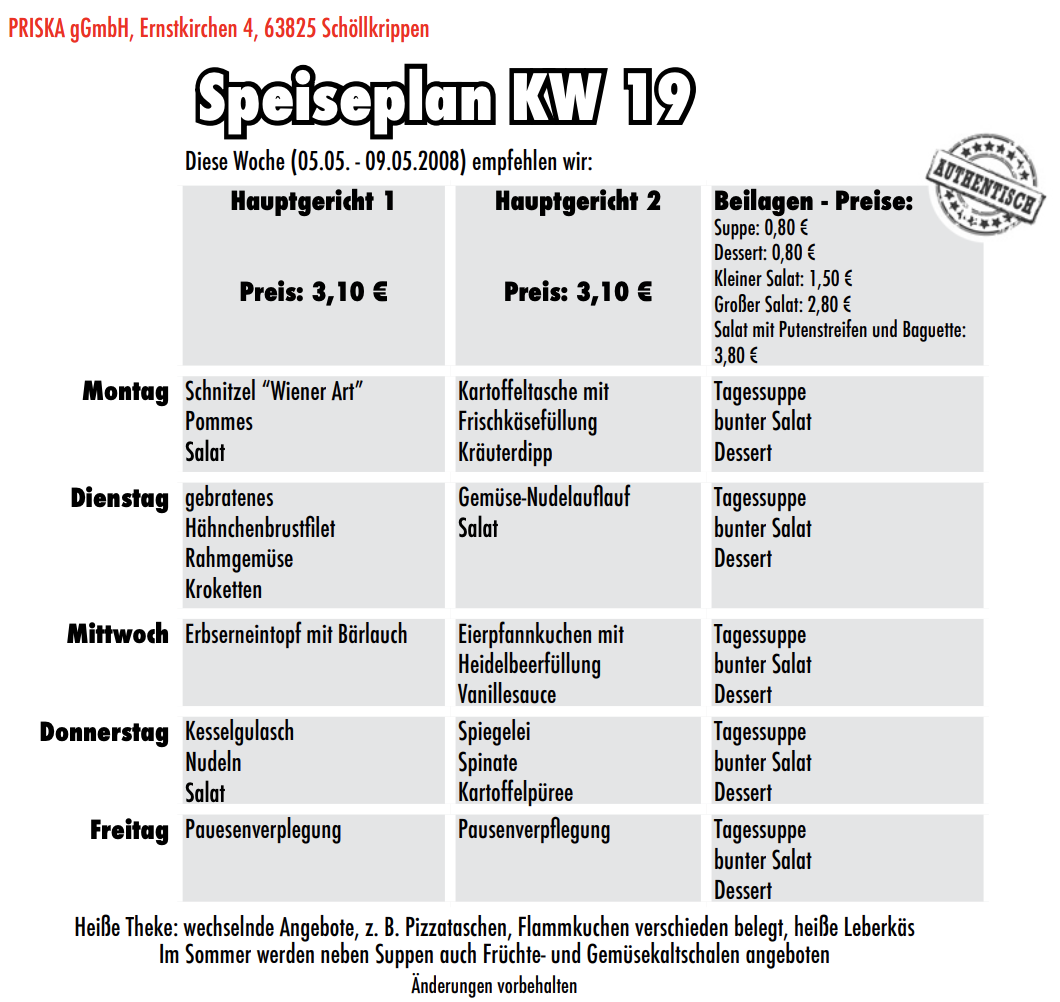
Aktivität 19. Sprache im Kontext: Döner
If going to the Mensa is not your thing, you can head out for a quick lunch at a Schnellimbiss (fast-food place). One of the most beloved Schnellimbisse in the German-speaking countries is the Dönerbude, where you can feast on a delicious Turkish specialty called Döner.
A. Watch the video “Döner” and write down what you think the man talks about.
What does he describe? What things does he mention/explain?
B. Was für Garnierungen (toppings) gibt es für Döner?
Watch the video again an check all items you hear. Afterwards write down the English word below the German word for the possible toppings.

C. Watch the clip again and complete the prompts:
1. Wie heißt der Mann?
2. Woher kommt er?
3. Welches Fleisch brät (roasts) er für die Döner?
4. Welche Garnierungen essen Sie gern und welche essen Sie gar nicht gern?
There are lots of different kinds of Döner at Dönerbuden: beef (Rindfleisch), chicken (Hähnchen) and lamb (Lammfleisch), for example.
Aktivität 20. Sprache im Kontext: Andrew und Austin: Döner kaufen
Watch the video „Andrew/Austin: Döner kaufen” several times and answer as many of these questions as you can.
1. Welche Garnierungen bestellen (to order) die Studenten?
Andrew bestellt einen Döner mit ____________________.
Austin bestellt einen Döner mit _____________________.
2. Bezahlen sie zusammen (together) oder getrennt (separate)? ______________________.
3. Wie oft essen sie Döner?
Andrew sagt: ________________________________________
Austin sagt: ________________________________________
Another Döner topping frequently served at Dönerbuden is a spicy red pepper sauce. When ordering at a Dönerbude which serves this sauce, you’ll be asked if you’d like yours „mit scharf” (with heat) or „ohne scharf” (without heat). You can try Döner with a variety of toppings (including this spicy red sauce) right here in Austin (where this book has its origin) at a Döner stand called ”Kebabalicious”. Check out their location and opening hours on the ”Kebabalicious” website http://www.austinkebab. com. Is there one in your town?
Aktivität 21. Das Mittagessen nicht verpassen!
If you’re thinking about skipping lunch today, you might want to think again. The story below – „Die Geschichte vom Suppen-Kaspar” – is a cautionary tale, one of ten stories in Heinrich Hoffmann’s famous Struwwelpeter (1845) collection, which chronicles the horrifying consequences of children’s mischief. Source: http://gutenberg.spiegel.de/buch/3070/17
A. Vor dem Lesen
Look at the illustrations accompanying the story. What do they tell you about the main character and what happens to him?
B. Nach dem Lesen – Fragen zur Diskussion
1. Summarize the story in your own words: who does what when, and what happens to him?
2. This is clearly a story with a moral. What is it?
3. What do you think the target age-group is? What do you base your response on?
4. How could you tweak the story for a contemporary child audience?
war: was
kerngesund: as fit as a fiddle ein dicker
Bub: a plump boy
kugelrund: round as a ball
hatte: had
Backen: cheeks
aß: ate
fing er an zu schrei’n: he began to shout
eß’: esse sieh
nur her!: just see here!
schon: already
magerer: thinner
wieder: again
o weh und ach!: oh, pain and sorrow!
dünn und schwach: thin and weak
kam herein: came in
endlich: finally
ein Fädchen: a little thread
wog: weighed
ein halbes Lot: equivalent to 7.5 grams
tot: dead
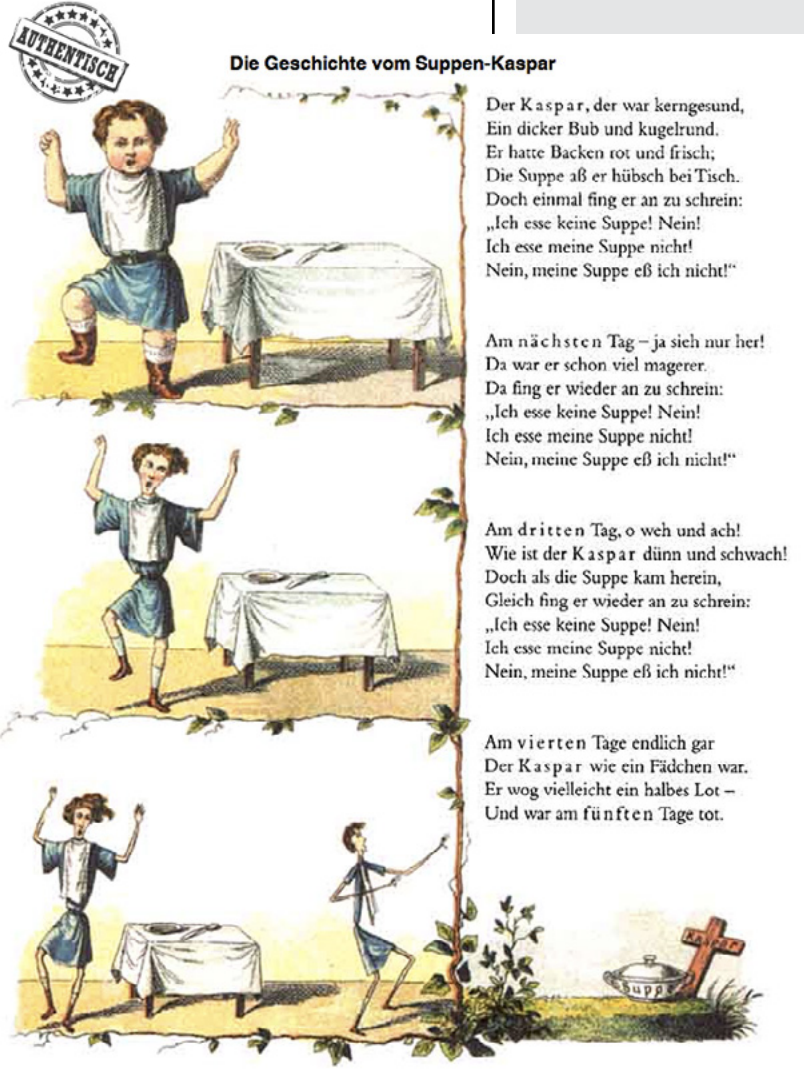
Aktivität 22. Was essen Sie nicht?
Ich esse’s nicht! In „Die Geschichte vom Suppen-Kaspar”, Kaspar’s stubborn refusal to eat soup is highlighted in the story’s refrain: „Ich esse keine Suppe! Nein!/Ich esse meine Suppe nicht!/Nein, meine Suppe eß’ ich nicht!” Is there something you would refuse to eat if it were served to you? Personalize the refrain by adding your own despised food item. (Don’t forget to use the Akkusativ case!)
Ich esse kein ______ _______________________________! Nein!
Ich esse mein ______ _______________________________ nicht!
Nein, mein ________ ________________________ eß’ ich nicht!“
Aktivität 23. Essgewohnheiten
What kinds of eating habits do your classmates have? Ask your classmates questions about what they like to eat, what not, who is a vegetarian, and so forth. Before asking your classmates, generate the specific questions you will need. If you find someone who matches the description, have them sign their name on the line. Make sure to ask and answer in German! Du: Isst du gern Pizza?
Student: Nein, ich mag keine Pizza.
Du: Ach, unterschreib hier, bitte!
Finden Sie jemanden, der ...
| 1. Pizza nicht gern isst. | |
| 2. Vegetarier/Vegetarierin ist. | |
| 3. nie Frühstück isst. | |
| 4. keine Milch trinken kann. | |
| 5. zu viel Schokolade isst. | |
| 6. mehr als fünf Tassen Kaffee am Tag trinkt | |
| 7. gerne Fisch isst. | |
| 8. schon Döner probiert hat. | |
| 9. sehr gut kocht. | |
| 10. jede Woche zum Essen ausgeht. |
Aktivität 24. Ein kurzer Bericht
On a separate sheet of paper, describe your own eating habits based on the above survey (i.e., Ich esse Pizza nicht gern. Ich bin Vegetarier/ Vegetarierin). IMPORTANT: Do not put your name down! Your instructor will collect the reports and read them; the whole class will try to guess whose eating habits are being described!
Aktivität 25. Kaffee trinken
Some type of caffeine is essential for many people, especially students! In the morning, students often rely on caffeine to wake up for their classes; in the afternoon and evenings, they need it to stay awake to get all their work done.
A. Brauchen sie Kaffee, um zu funktionieren?
Watch each speaker’s video clip, „Brauchen Sie Kaffee?” and decide whether the following statements are true or false. Then correct the false statements to make them true.
1. Adan: Fast gar nicht. Vielleicht [trinke ich] eine Cola oder etwas, aber nichts anderes. T F
2. Eva: Ich trinke ganz gern Kaffee. Es ist lebensnotwendig (vital). T F
3. Harald: Ich trinke zwei große Tassen Espresso jeden Morgen. T F
B. Trinken Sie Kaffee, um zu funktionieren?
Do you drink coffee to remain a functioning individual? What about your partner? Discuss the following questions with him/her:
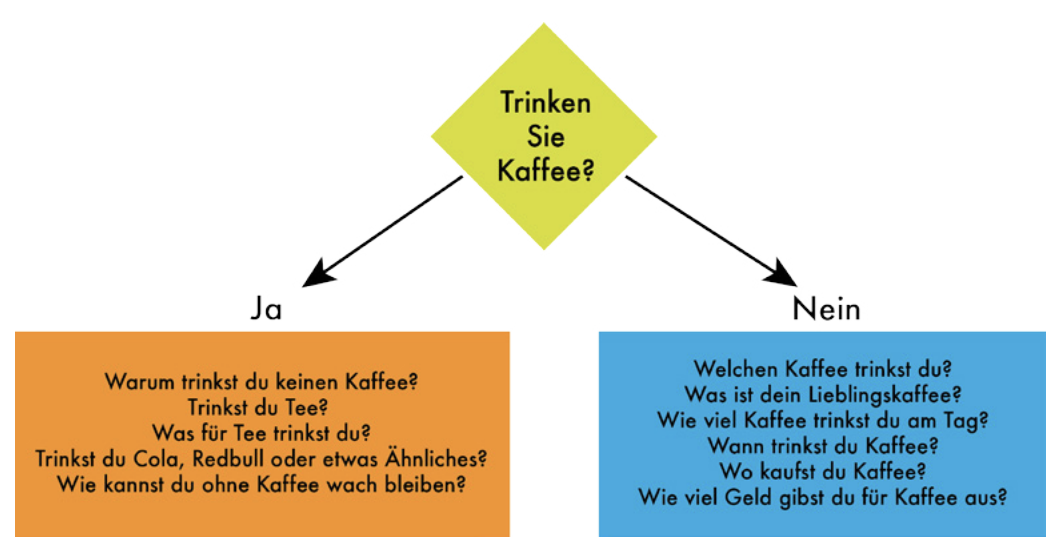
Aktivität 26. Sprache im Kontext: Eis!
A very popular dessert, especially in the summer heat, is Eis (ice cream), which comes in lots of creamy flavors and can be served in a Waffel (cone) or a Becher (cup). It can be served by itself or with amazing toppings and decorations. At roughly .70 – 1.50 Euro per Kugel (scoop; lit: ball), it is a pricey treat, but the taste and the experience are worth every cent! Keep in mind that the German ice cream is like gelato and not like American ice cream.
A. Die Eisdiele
Many Eisdielen in Germany are family businesses run by German-Italian families. In the following you will meet Vincenzo, a German-Italian (surprise) who runs a Eisdiele in Brühl, a town close to Cologne. The following paragraph is taken from http://www.inbruehl.com/ about his ice cream parlor. Then complete the exercises below and discuss in pairs or/and with your teacher, what you understand and what you do not understand.
Eiscafe il Gelato da Vincenzo – Uhlstraße 59
Wer die Eiskarte des Ehepaars Petra und Vincenzo Caico liest, erfährt sehr schnell die Philosophie des Eiscafe il Gelato da Vincenzo. Hier steht die Herstellung eines qualitativ höchstwertigen Lebensmittels im Mittelpunkt, das wertvolle Vitamine und Proteine enthält. Die Verwendung von Frischmilch, natürlicher Süße, frischem Obst und pflanzlicher Fette garantiert neben der besonderen Cremigkeit des Speiseeises einen hervorragenden Geschmack und auch eine sehr gute Bekömmlichkeit. Auf Farbstoffe, Eier, Sahne und Butter wird ganz bewusst verzichtet. Eine genau festgelegte Rezeptur und die zügige Verarbeitung sorgen für einen gleichbleibend hohen Qualitätsstandard des Eis’, den der Eisgenießer sofort schmeckt. Auch die Wahl der Kaffeebohnen-Sorten entspricht diesem Anspruchsdenken. Ihre privaten Einstellung, bewusst und konsequent gesund zu leben, führte zum Entschluss, ihr Café zum Nichtraucher-Café zu erklären. Ihr Grundsatz “Eis, ein edler Genuss, statt Masse bei uns Klasse!” erfreut sich in Brühl großer Beliebtheit.
Öffnungszeiten: täglich 9 - 22 Uhr, Montag Ruhetag Telefon: 02232 - 94 37 38
List 2 words you know:
List 2 words you look up:
List 2 words your partner knows:
What makes das Esicafe il Gelato da Vincenzo special?
B. Ice Cream Flavors
Watch the video „Sprache im Kontext: Eis”. What ice cream flavors are mentioned in the clip?

KULTURTIPP
Tipping – Trinkgeld – in Germany is done differently than in the US. Instead of giving 15- 20% of the total as a tip, you round up. For example, if your Eis was 2 Euro 70, you can give the waiter 3 Euros (i.e., a 30-cent tip). Or you can give him a 5-Euro Schein (bill) and say „(Auf) drei, bitte!” (i.e., give me 2 Euros back) or only take 2 Euros from the tray. The larger the bill, the more you round up (e.g., for a 76 Euro bill, you would leave “only” about 4 Euros. However, if you just buy ice cream or something at an Imbiss you don’t have to leave a tip, although it will be appreciated if you do.
C. Bei Da Vincenzo
Watch the video „Sprache im Kontext: Eis” to put the following statements in the correct order.
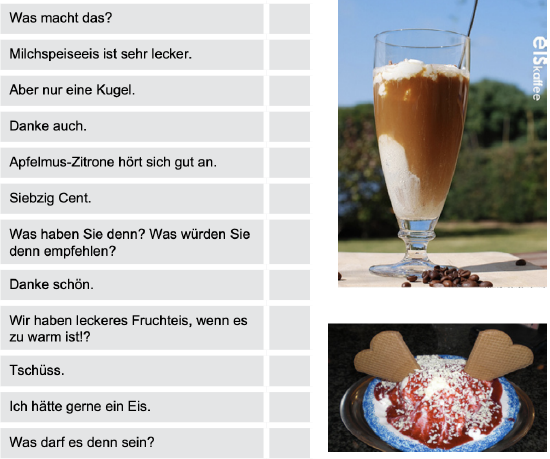
D. Milch oder Frucht?
What is the difference between Milcheis and Fruchteis? List three Milcheis and two Fruchteis flavors (use the vocabulary you have learned in this chapter!) that are not mentioned in the clip.
Milcheis ist ______________________________________________________________ .
Fruchteis ist _____________________________________________________________ .
E. Jetzt sind Sie dran!
With a partner, act out an ice-cream buying event. First, the sales person typically asks what the customer wants, and the customer chooses one ore more flavors (more than 4 Kugeln and you should get a Becher or lots of Servietten!). Then the sales person lets you know how much to pay. After you pay, he/she gives you back your change. Fill in the dialog, and practice asking/answering these questions. FYI: These are phrases our students learned very quickly in Germany! ☺
VerkäuferIn: Was darf`s sein?
Sie: Ich möchte/Ich hätte gerne _____________ (eine Kugel, zwei Kugeln ...)
VerkäuferIn: In einer Waffel oder im Becher?
Sie: ______________________________________________________ , bitte.
VerkäuferIn: Bitte schön. _______________ Euro ___________________________ .
Sie: ____________________________________________________________
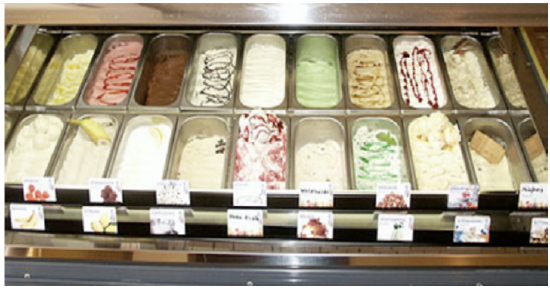
Aktivität 27. Zu Abend essen
It’s time to take a little break from your work and get a bite to eat. In German there are two words that are used to talk about an evening meal: das Abendbrot and das Abendessen. In groups of three, brainstorm some ideas about why there are two words and what the difference between them might be. (Do not look on the next page, unless you want to spoil the fun!)
| das Abendbrot | das Abendessen |
Aktivität 28. Das Abendbrot – Die wichtigste Famil- ienmahlzeit Deutschlands
The following article appeared in the Berliner Zeitung on March 26, 2008.
A. Vor dem Lesen
1. Look at the title („Allein am Frühstückstisch“) and subheading („Umfrage zu Essverhalten“) of the passage below. Based on these clues, what do you think the focus of the passage is?
in jeder dritten Familie: in every third family
Kinder: children
während der Woche: during the week
gemeinsam: together
noch seltener: even more seldom
einer Umfrage nach: according to a survey
jede vierte Familie: every fourth family nimmt ...
ein: to take in (i.e., food)
dagegen: in contrast
gab ... an: indicated
mindestens: at least
am häufigsten: most frequently
drei Viertel: three-fourths
Wert darauf legen: to make a point of doing something
aufessen: to eat up müssen: to have to

B. Fragen zur Diskussion
From what you just learned about family Essverhalten (eating practices) in Germany, and based on your own experience, would you say that they are the same in the US? In your family? For example, is dinner the most important meal for your family? Lunch? Breakfast? Why/why not? Before discussing take a few notes, that are helpful to bring your points across.

KULTURTIPP
In the German-speaking countries, dinner is traditionally a cold meal. This Abendbrot, as it is called, consists of a variety of breads, meats and cheeses out of which belegte Brote (open-faced sandwiches) are made. Salads may also be eaten. This tradition of eating a cold meal for dinner is slowly changing, however. Today, many people in the German-speaking countries have reversed what they eat for lunch and dinner. That is, instead of eating a warm meal for lunch and a cold meal for dinner, they eat a cold meal for lunch and a warm meal for dinner. The term Abendessen (i.e., as opposed to Abendbrot) reflects this recent tendency to eat a warm meal for dinner.
Aktivität 29. Einkaufen gehen
Unless you go to a restaurant, you need to buy groceries before you can eat. Just as you need to purchase other items for your everyday life.
Where do you need to go and what will you buy?
Geschäfte/Läden Ich gehe ...
die Apotheke → zur Apotheke.
die Bäckerei → zur Bäckerei.
die Bank → zur Bank.
die Buchhandlung → zur Buchhandlung.
die Drogerie → zur Drogerie.
die Post → zur Post.
der Friseur → zum Friseur.
der Gemüseladen → zum Gemüseladen.
der Papierladen → zum Papierladen.
der Supermarkt → zum Supermarkt.
das Schuhgeschäft → zum Schuhgeschäft.
To talk about running errands, you can use any of the following phrases:
• etwas besorgen (to go get something) Ich gehe zur Post und besorge Briefmarken.
• etwas einkaufen (to go get something) Ich gehe zum Supermarkt und kaufe Butter ein.
• etwas holen (to go get something) Ich gehe zum Bäcker und hole Bro.
Aktivität 30. Sprache im Kontext: Sophia im Supermarkt
Watch the video clip „Sophia im Supermarkt“.
A. Write down what you notice in the clip.
What is Sophia talking about? What items does she mention?
B. Watch the clip again.
Sophia discusses what she needs at the Supermarkt every week. Fill in the items she mentions that are missing from her wöchentlichen Einkaufszettel (weekly grocery list) below.

Welche Lebensmittel kann man im Supermarkt kaufen? Feel free to add your favorties, if they are not on the list.
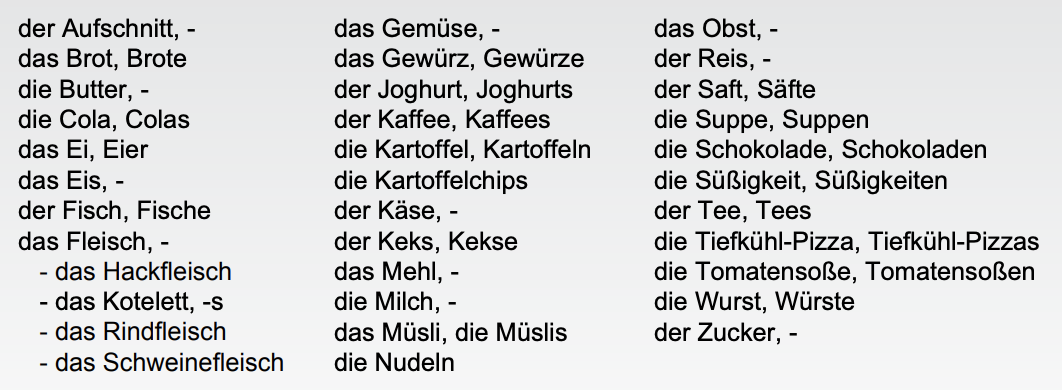
Aktivität 31. Sprache im Kontext: Obst und Gemüse
Watch the two videos of a Würzburg green grocer and her prized Obst (fruits)and Gemüse (vegetables). Write down what each item listed below costs and (if she mentions it) the origin. Use the words in the word bank to help you! Can you figure out from the videos which fruit and/or vegetable is which?
teilweise • kilogrammweise schälchenweise • pro Stück • Klima aus dem Ausland • einheimisch unbehandelt • Saison
| Obstart | Preis | Woher kommt das Obst? |
| Äpfel | ||
| Birnen | ||
| Ananas | ||
| Bananen | ||
| Trauben | ||
| Wassermelonen | ||
| Zitronen | ||
| Pfirsiche | ||
| Kirschen | ||
| Erdbeeren |
| Gemüseart | Preis | Woher kommt das Gemüse? |
| Gurken | ||
| Champignons | ||
| Karotten | ||
| Paprika | ||
| Bohnen | ||
| Blumenkohl | ||
| Salat | ||
| Tomaten |
Aktivität 32. Obst und Gemüse essen
Now that you know the names of the different Obst und Gemüse, how many of these do you actually eat? Which ones do you not like? Ask a partner and jot down his/her response. Be prepared to share your partner’s answers with the class!
1. Was für Obst isst du?
2. Was für Obst isst du nicht (gern)?
3. Was für Gemüse isst du?
4. Was für Gemüse isst du nicht (gern)?
Aktivität 33. Sprache im Kontext: Austin kauft ein
Watch the Video entitled „Austin beim Einkaufen“ and see what you can understand after each viewing of the clip.
A. During the first viewing, write down what you see.
What do you notice about in the video? Who is in it? Where does it take place? What do you think is it about?
B. Watch the clip again and write down all the groceries you hear in the clip.
C. Watch the clip a third time and answer the questions below.
1. Was brauchen Austin und Andrew nicht?
2. Was für Cereals kaufen Sie?
D. Watch the clip one more time and write down all the adjectives you hear in the video (the adjectives that are used to describe the products).
Aktivität 34. Milka-Schokolade – Werbung und Recherche im Internet
In a previous Sprache im Kontext video you saw Andrew and Austin expressing their love of Milka-Schokolade, a popular brand of chocolate in the German-speaking countries. In the following you will do a Recherche (research) on the brand and its Werbung (advertisement). To get you started, the name Milka is an acronym of Milch and Kakao, chocolate’s two primary ingredients.
A. Vor der Inernetrecherche – Fragen zur Diskussion
• Have you ever tried German or Swiss chocolate (for example, Kinderschokolade, Lindt, Ritter Sport, etc.)?
• Did it taste different from American chocolate?
• Have you ever tried Milka-Schokolade before? If so, how did it taste?
Nützliche Wörter: die Luft • die Alpenmilch • nah • die Marke das Produkt • der Himmel • die Versuchung zart • lila • die Kuh
B. Die Internetrecherche
Go to www.milka.de. What can you do on the Milka website? What are the categories on the top of the page? Which category would you like to explore more? What do you learn about Milka?
Notizen:
C. Die Werbung
On the Milka website and click Marke, and then TV-Spots. Chose a clip or alternatively, search for „Milka TV Werbung 1996” on youtube. We transcribed the dialogue for this commercial.
das Mädchen: Omi, wieso ist die Milka so zart?
die Omi: Viele glauben, es liegt am klaren Wasser und der frischen Luft, oder man sagt, es ist wegen der cremigen Alpenmilch. Aber wenn du mich fragst, Herzel, liegt’s daran, weil es hier oben, wo die Milch herkommt, ganz nah am Himmel ist.
D. Nach dem Schauen/Lesen – Fragen zur Diskussion
1. How would you describe each person, the setting and the Milka itself? Take notes in the table:
| The girl/ character 1 | The grandmother/ character 2 | The setting | Milka-Schokolade |
2. How does the commercial try to “lure” you in? Is it successful? Does the commercial make you want to eat Milka-Schokolade? Why or why not?
E. Jetzt sind Sie dran!
How would you market Milka-Schokolade? In groups of three, create your own commercial, app or website content for the product. Before you begin, you might want to consider the following questions:
- Will there be “characters”? If so, who will they be? If not, why not?
- Where and when will the dialogue and/or action take place?
- Are you going for a comedic effect, a dramatic effect, or something else entirely?
- How will you place the purple Milkakuh, a mandatory element of all Milka commercials?

Aktivität 35. Mein Lieblingsrezept
Go online to the following webpage: http://www.marions-kochbuch.de/
A. Search for a recipe that you like to try.
You can search by name or by category on the left side of the screen (e.g. Suppen, Gemüse, Eierspeisen, Fleisch, Salate, etc.). After you found your dish write down the name of the dish and all the Zutaten (ingredients) you would need to get for it (don’t forget the quantities). Make sure you know what those ingredients are.
Beispiel: Das will ich kochen: Schweinebraten mit Blaukraut Zutaten: 900 g Schweinebraten 600 g Rotkohl ...
Das will ich kochen: _________________________________________
B. Go to http://www.aldi-sued.de, www.lidl.de or www.kaisers.de
All three links will bring you to popular discount grocery stores. Search one of the websites for their grocery products (das Sortiment) and create an Einkaufszettel (grocery shopping list). Since you still need practice with the Euro and Zahlen, also write down how much each ingredient/item would cost.
Mein Einkaufszettel
_______________________________
_______________________________
_______________________________
_______________________________
_______________________________
_______________________________
_______________________________
_______________________________
_______________________________
Aktivität 36. Sprache im Kontext: In der Drogerie
In addition to food items, you also need a variety of personal hygiene products. Listen as Florian explains what kinds of things one can buy at a Drogerie. All the items he mentions are in the left column below.
A. Can you match these German terms with their English equivalents in the right column?

Watch the video a second time. Which additional items do you see in the store that Florian does not specifically mention?
B. Im Schreibwarengeschäft
As a university student, you will need notebooks, paper, pens and other school items. While watching Florian’s clip about the Papierladen, write down the items he mentions. As a guide, the first letters of the words he mentions are provided to you. (Note: one complicated word is provided to you in its entirety ☺). This exercise will help refine your sound-symbol association (i.e., how something sounds and the way it is written). Don’t consult your dictionary until you’ve given it the ol’ college try!

Aktivität 37. Der erste Schultag
You may be wondering just what exactly the Lösungswort and the image of the item on the previous page is. In Germany, elementary school children receive one of these on the first day of school (see the image below, the girl is holding a Schultüte). They are filled with different kinds of Süßigkeiten and Schulsachen for the children to enjoy. The tradition dates back to the early 19th century! Now, flash forward to today; your German friend is starting his/her first day at your university, and you want to welcome him/her with a university-level version of the classic Schultüte – eine Unitüte! What do you put in your German friend’s Unitüte? Include at least 6-8 items.

Now draw a picture of this Unitüte with all the goodies inside. Use the space below, and label the items in the Tüte (using the nominative case)!
Studi-Tipp: You may use your Unitüte as a Vocabbox. Write all relevant vocab on slips of paper (English on the front, German on the back) and put them in your Unitüte. Each day test yourself. Whenever you know a card, you can leave it out - once your Unitüte is empty restock it with new words. But dont forget to reward yourself with some Milka, Kinderschokolade or Gummibärchen.
Aktivität 38. Zur Uni fahren (zurück zum Campus)
After having done all your shopping, you need to return to your dorm room at the end of the day. How can you get to your shopping and then home? Do you ride your bike or take the bus?
A. Match the names of the different modes of transportation on the left with the appropriate pictures on the right.
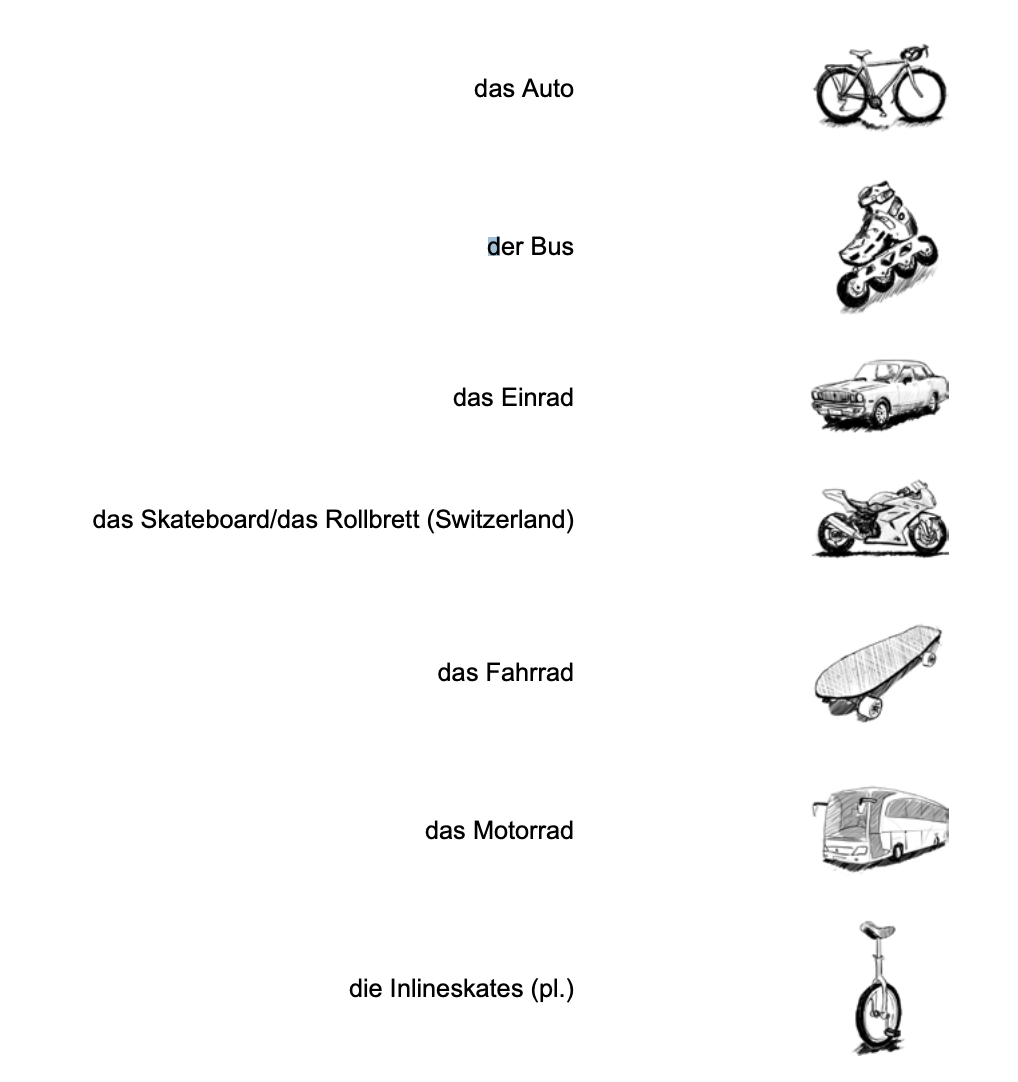

B. Wie wir an die Uni gehen
Which modes of transportation do you and your classmates use? A student or the teacher should ask the class how many students travel by each mode of transportation and note the number of responses on the board. Follow along by marking the numbers in the column on the right. When the poll is done, discuss as a class why these particular modes of transportation are the most common.
Wer fährt mit dem Auto zur Uni?
Wer fährt mit dem Bus zur Uni?
Wer fährt mit dem Einrad zur Uni?
Wer fährt mit dem Fahrrad zur Uni?
Wer fährt mit dem Motorrad zur Uni?
Wer fährt mit den Rollschuhen zur Uni?
Wer fährt mit dem Skateboard zur Uni?
Wer geht zu Fuß/läuft zur Uni?
Nota Bene: Another verb you can use to talk about your means of transportation is the verb nehmen (to take). Just as you can say in English “I take the bus,” in German you say „Ich nehme den Bus”.
Aktivität 39. Neue Studenten in Austin!
A. Brainstorming
You’ve worked with a lot of information in this chapter which will help you during your study abroad in Würzburg. What if the international studies office approached you to generate material to help German-speaking students in your city? Below is a table with a number of topics which were featured in the chapter. Write down information you think should be included for new students.
As you write, consider that these students will have certain expectations about where and how to do what and those expectations might or might not coincide with what is available here. For example, if you are used to going to a Schreibwarenladen for pens and paper, what are you going to do if you live on or near campus? The following questions might help you get started.
• Wo frühstückt man?
• Wie sieht ein “typisches” Studentenfrühstück aus?
• Gibt es eine Bäckerei in der Nähe vom Campus? Wo findet man frische Backwaren?
• Wenn man Kulis oder mehr Schreib- oder Druckpapier braucht, wo kauft man das alles?
• Wo kauft man Lebensmittel ein? Machen Studenten das überhaupt (at all) oder isst man immer in der Mensa oder in einem Restaurant?
• Wie kommt man meist zur Uni?
|
Frühstück Mittagessen Abendessen/Abendbrot |
|
| Beschäftigungen und Einkaufen | |
| Tagesablauf |
B. A Handout
Now, work in a group and design an informational pamphlet to be included with other welcome material for these new students. You may make it of general focus or you can concentrate on one specific topic. Pool your resources and think about how best to help transition into life in your town!


